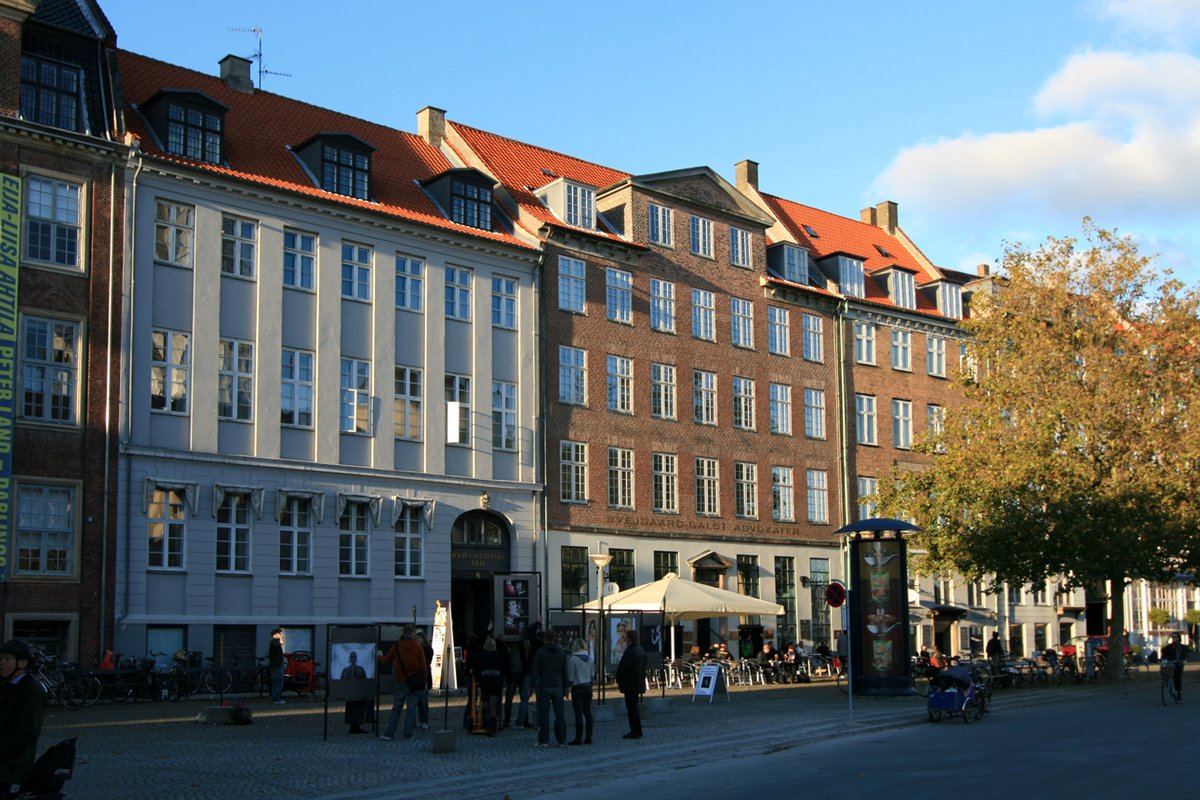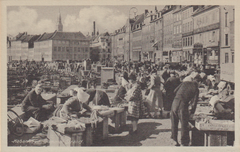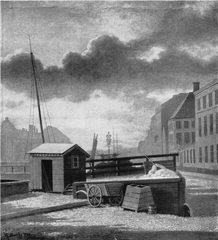
Gammel Strand Copenhagen: Visiting Hours, Tickets, and Historical Sites Guide
Date: 03/07/2025
Introduction: Why Visit Gammel Strand?
Set along the scenic Slotsholmens Canal in central Copenhagen, Gammel Strand is a vibrant fusion of history, culture, and contemporary urban life. Once Copenhagen’s medieval harbor and later its main fish market, Gammel Strand (“Old Beach”) has evolved into a picturesque waterfront promenade lined with colorful 18th- and 19th-century townhouses. Today, it serves as both a gateway to Copenhagen’s past and a hub for modern arts, anchored by the renowned Kunstforeningen Gammel Strand art center. This guide provides comprehensive, up-to-date information on visiting Gammel Strand, including its historical significance, opening hours, ticketing, nearby attractions, and practical travel tips (Gammel Strand - About; Visit Copenhagen; Travel Guide).
Table of Contents
- Historical Overview: From Medieval Harbor to Cultural District
- Architectural Heritage and Landmarks
- Kunstforeningen Gammel Strand: Art and Innovation
- Visiting Hours, Tickets, and Accessibility
- Getting There: Transport and Location
- Top Nearby Attractions
- Dining, Shopping, and Experiences
- Events and Seasonal Highlights
- Practical Travel Tips and Safety
- Frequently Asked Questions (FAQ)
- Summary and Visitor Recommendations
- Further Resources
Historical Overview: From Medieval Harbor to Cultural District
Gammel Strand’s roots reach back to the 11th century, when it served as the natural harbor and origin point for Copenhagen’s earliest settlement (Museum of Copenhagen, 2016). By the late Middle Ages, the area had become the city’s main harbor, facilitating commerce and international exchange. From the 1800s until 1958, Gammel Strand was synonymous with the city’s lively fish market, where fishermen’s wives—commemorated by the statue “The Last Fisherman’s Wife”—sold their daily catch along the quay (Travel Guide). Although the market is long gone, the area’s legacy as a hub of social and economic life endures.
Architectural Heritage and Landmarks
The north side of Gammel Strand features a harmonious row of brightly colored townhouses, most rebuilt after the fires of 1728 and 1795 (Wikipedia). Among them, No. 48—constructed in 1750 by Philip de Lange—stands as a testament to the city’s resilience and architectural continuity (DAC). Today, this protected building houses the Kunstforeningen Gammel Strand, blending historical architecture with contemporary cultural programming.
Kunstforeningen Gammel Strand: Art and Innovation
Founded in 1825 by citizens including C.W. Eckersberg, Kunstforeningen was established to make art more accessible beyond the elite circles of the Royal Danish Academy of Fine Arts (Gammel Strand - About). Relocating to Gammel Strand in 1952, the institution has continually evolved, culminating in a major renovation in 2010 and a rebranding in 2024. Now simply “Gammel Strand,” it is a leading platform for contemporary art, hosting 6–8 exhibitions annually with a focus on emerging talents and critical engagement with current issues (Visit Copenhagen).
Facilities include:
- Accessible exhibition spaces
- An art, magazine, and bookshop
- Spaces for lectures, performances, debates, and community events
- The basement café Lille Fugl, known for its welcoming atmosphere and award-winning baked goods
In 2025, the institution celebrates its 200th anniversary with the group exhibition “Når vi døde vågner (When We Dead Awaken)” (Gammel Strand Exhibition Program).
Visiting Hours, Tickets, and Accessibility
Gammel Strand (the promenade):
- Open 24/7, year-round; free access
Kunstforeningen Gammel Strand (art center):
- Open Tuesday to Sunday: 11:00 AM – 6:00 PM (occasionally until 5:00 PM; check the official website for updates)
- Closed Mondays
- Admission: Free to all exhibitions
- Guided tours: Available by advance booking; check website for schedules
Accessibility:
- The promenade and art center are wheelchair accessible
- Ramps, elevators, and accessible restrooms are available, though some cobblestones may be uneven
Getting There: Transport and Location
- Metro: Gammel Strand Metro Station (M3 Cityringen) is directly adjacent
- Bus: Several lines stop within a short walk
- By foot: 5 minutes from Kongens Nytorv, 4 minutes from Strøget
- Bicycle: Ample bike lanes and parking nearby
- Car: Parking is limited; public transport or cycling is recommended (Metro Copenhagen)
Top Nearby Attractions
- Christiansborg Palace: Home to the Danish Parliament and Royal Reception Rooms, just across the canal
- Thorvaldsens Museum: Dedicated to sculptor Bertel Thorvaldsen (2 min walk)
- Nyhavn: Iconic harbor known for its colorful houses (10 min walk)
- National Museum of Denmark: Danish history and culture (5 min walk)
- Strøget: Major pedestrian shopping street (4 min walk)
- Black Diamond: Modern extension of the Royal Danish Library (9 min walk)
- Jazzhus Montmartre: Historic jazz club (10 min walk)
- Karel van Mander House: Historic building (7 min walk)
- Strædet: Trendy shops and cafes (2 min walk) (Trek Zone)
Dining, Shopping, and Experiences
- Cafés and Restaurants: Wide variety along the canal, offering Danish specialties like smørrebrød and fresh seafood (Evendo)
- Boutiques and Shops: Art books, local design, and souvenirs, especially at the art center’s shop (Copenhagen Card)
- Canal Cruises: Departures from Gammel Strand’s quay provide unique city views (Travel Guide)
- Nightlife: Lively bars and cafés along the canal stay open late
Events and Seasonal Highlights
- Copenhagen Jazz Festival (July): Concerts at venues like Jazzhus Montmartre (All Events in Copenhagen)
- Outdoor Markets: Flea markets and art fairs are held throughout the year
- Cultural Festivals: The square hosts performances and special events, especially during summer
Practical Travel Tips and Safety
- Currency: Danish Krone (DKK); cards widely accepted
- Language: Danish, but English is commonly spoken
- Weather: Summers are mild (20–22°C/68–72°F); rain possible year-round
- Dress: Comfortable shoes for cobblestone areas; layered clothing
- Wi-Fi: Free in most cafés; public Wi-Fi hotspots available
- Families: Stroller and wheelchair accessible, though some cobblestones can be uneven
- Safety: Generally very safe, but beware of pickpockets in crowds
Frequently Asked Questions (FAQ)
Q: What are Gammel Strand’s opening hours?
A: The promenade is always open; Kunstforeningen Gammel Strand is open Tuesday–Sunday, 11:00 AM–6:00 PM (sometimes until 5:00 PM).
Q: Is there an admission fee?
A: No, both the promenade and art center exhibitions are free.
Q: Is Gammel Strand accessible for visitors with disabilities?
A: Yes, most areas are accessible, though some cobblestones may be uneven.
Q: Are guided tours available?
A: Yes, check the official website for current tour schedules and booking.
Q: How do I get to Gammel Strand?
A: Use the Metro (M3 Cityringen) or nearby bus lines; biking and walking are also easy.
Q: Are canal cruises available?
A: Yes, tickets can be bought online or at the quay.
Summary and Visitor Recommendations
Gammel Strand is a living testament to Copenhagen’s rich maritime and cultural heritage, offering visitors a blend of historic architecture, contemporary art, and dynamic urban life. With free admission, easy accessibility, and proximity to major attractions, it’s an essential stop for anyone exploring Copenhagen. Enjoy exhibitions at Kunstforeningen, stroll the colorful waterfront, take a canal cruise, or simply relax in a café—Gammel Strand promises memorable experiences at every turn.
Plan your visit:
- Check the official Gammel Strand website for current exhibitions, events, and guided tours.
- Download the Audiala app for audio guides and exclusive content.
- Explore further travel resources below.
Further Resources
- Gammel Strand - About
- Visit Copenhagen - Gammel Strand
- Travel Guide - Gammel Strand
- Kunstforeningen Gammel Strand Official
- Metro Copenhagen
- Trek Zone Gammel Strand page
- Copenhagen events calendar
- Copenhagen Card - Gammel Strand
- DAC - Gammel Strand 48


























































































